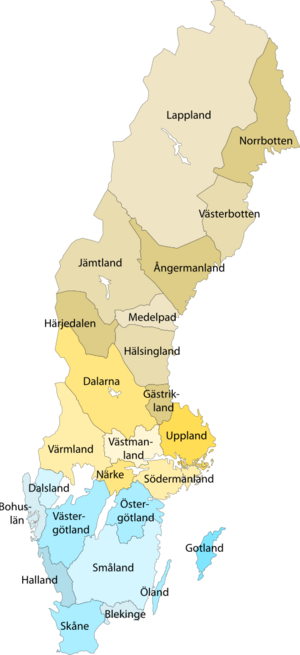Provinces of Sweden facts for kids
The Provinces of Sweden (called Sveriges landskap in Swedish) are 25 old, traditional areas in Sweden. Long ago, in the Middle Ages, these provinces had their own rules and laws. But in 1634, Sweden created new areas called counties. After that, the old provinces were no longer used for government or political reasons.
However, even today, these historical provinces are still very important for Sweden's culture and how people identify with their region. They help tell the story of Sweden's past and its different local traditions.
What Are the Provinces Called?
Each of Sweden's 25 historical provinces has its own name. Many of these names have been used for hundreds of years! Below is a list of the provinces, showing their Swedish names and their Latin names, which were often used in older maps and documents.
| Swedish Name | Latin Name |
|---|---|
| Ångermanland | Angermannia |
| Blekinge | Blechingia |
| Bohuslän | Bahusia |
| Dalarna | Dalecarlia |
| Dalsland | Dalia |
| Gotland | Gotlandia |
| Gästrikland | Gestricia |
| Halland | Hallandia |
| Hälsingland | Helsingia |
| Härjedalen | Herdalia |
| Jämtland | Jemtia |
| Lappland | Lapponia Suecana |
| Medelpad | Medelpadia |
| Norrbotten | Norbothnia |
| Närke | Nericia |
| Öland | Olandia |
| Östergötland | Ostrogothia |
| Skåne | Scania |
| Småland | Smolandia |
| Södermanland | Sudermannia |
| Uppland | Uplandia |
| Värmland | Wermlandia |
| Västmanland | Vestmannia |
| Västerbotten | Vestrobothnia |
| Västergötland | Westrogothia |
Images for kids
See also
 In Spanish: Provincias históricas de Suecia para niños
In Spanish: Provincias históricas de Suecia para niños




